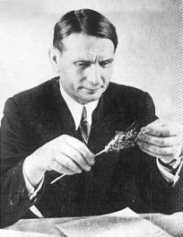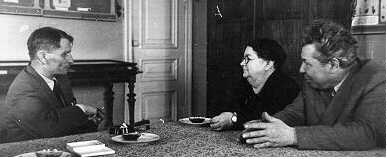| Lysenko's role in the development of agricultural science in the USSR |  |
After the revolution of 1917, Russian agriculture, which had been flourishing, began to decline for physical and organizational reasons. Stalin and his associates faced the challenge of enhancing all spheres of agricultural production in the face of problems due to the food production apportionment practised during Militant Communism, the Civil War of the early 1920s, periodical droughts in the most important crop production areas in the Volga region and the Ukraine, and industrialization with subsequent collectivization of the whole country in the early 1930s. This required a simple and quick solution. At that time, individuals appeared who offered seemingly easy ways of solving the problem. However, they confused what was desirable with what was actually obtainable. One of these individuals was T.D. Lysenko.
 Lysenko (1898-1976) was the son of a peasant. He attended horticultural schools in Poltava (1913) and Uman (1917-1920). In 1921 he took courses offered by the Sugar Trust and worked in its experimental stations at Verkhiachka near Kiev (1921) and Belaya Tserkov (1922-1925). He studied agronomy at the Kiev Agricultural Institute from 1921 to 1925. Lysenko first rose to national prominence while posted in Gandzha in Azerbaidzhan (1925-1929). As head of legume selection at an experimental station, he introduced pea varieties from Kiev that were early ripeners, but some became late ripeners in Gandzha. He concluded that this plant characteristic depends less on the breed than on the conditions under which it was grown. He decided that low temperature was related to late ripening and it was possible to produce desirable characteristics by manipulating the growing conditions. In order to make winter wheat sowable in the spring, he suggested that germinating seeds be buried in snow before planting; this reportedly led to greatly increased yields. Lysenko termed this procedure "vernalization" and its apparent success brought his work to the attention of agricultural officials. The idea of vernalization, which made Lysenko popular in scientific circles, was formulated by him in l929 at the All Union Congress on Genetics and Plant breeding. In the same year he was given a laboratory in the physiology division of the All-Union Institute of Genetics and Selection in Odessa (Ukraine).
Lysenko (1898-1976) was the son of a peasant. He attended horticultural schools in Poltava (1913) and Uman (1917-1920). In 1921 he took courses offered by the Sugar Trust and worked in its experimental stations at Verkhiachka near Kiev (1921) and Belaya Tserkov (1922-1925). He studied agronomy at the Kiev Agricultural Institute from 1921 to 1925. Lysenko first rose to national prominence while posted in Gandzha in Azerbaidzhan (1925-1929). As head of legume selection at an experimental station, he introduced pea varieties from Kiev that were early ripeners, but some became late ripeners in Gandzha. He concluded that this plant characteristic depends less on the breed than on the conditions under which it was grown. He decided that low temperature was related to late ripening and it was possible to produce desirable characteristics by manipulating the growing conditions. In order to make winter wheat sowable in the spring, he suggested that germinating seeds be buried in snow before planting; this reportedly led to greatly increased yields. Lysenko termed this procedure "vernalization" and its apparent success brought his work to the attention of agricultural officials. The idea of vernalization, which made Lysenko popular in scientific circles, was formulated by him in l929 at the All Union Congress on Genetics and Plant breeding. In the same year he was given a laboratory in the physiology division of the All-Union Institute of Genetics and Selection in Odessa (Ukraine).
Lysenko's peasant background gave him an important advantage. His techniques may have seemed to offer an immediate way of overcoming the food shortage occasioned by the collectivization of agriculture. Their implementation fitted the social organization of the "kolkhoz" and the "sovkhoz", the collective and state farms which were prominent features of Soviet agriculture.
Work on frost hardiness and the effect of low temperatures had been known long before, and researchers of the Institute of Plant Industry had worked on this subject under the leadership of Dr N.A. Maximov. The Department of Physiology worked on the effects of low temperatures, daylength and moisture on cereal and other crops. However, the impressive and scientifically reliable results promised by Lysenko were never obtained. In his letter addressed to I.G. Eikhfeld at the Polar Experimental Station, Vavilov appreciated and supported Lysenko's work.
All that is and has been done by T.D. Lysenko is of exceptionally great interest, and the Polar department needs to enhance such activities.
At the same time, in his letter to N.V. Kovalev he wrote:
In 1932, Yu.A. Yakovlev, People's Commissioner for Agriculture, entrusted Vavilov, as a member of the Board of the Academy, with an errand to review the current state of Lysenko's works and render all kinds of assistance to him. Vavilov wrote to Lysenko:
When recommending Lysenko for an award in 1933, Vavilov wrote:
Vavilov attributed great importance to this trend in research and always tried to find and identify a grain of truth in this phenomenon, and in the results and practical recommendations made by Lysenko. Vavilov suggested that in agricultural practice this idea could be used to accomplish the shift of southern crops northwards, and in science it would help to regenerate collection accessions of winter crops in the first year of reproduction, or to apply such conditions as a stimulating environment, in selection for breeding purposes and for obtaining hybrids from the parents with asynchronous phases of development.
Vavilov wrote to Lysenko in 1934:
In 1934, Vavilov, who continued studying this phenomenon, recommended that Lysenko be elected Corresponding Member of the Academy of Sciences. In his reference he wrote:
 During the heyday of Soviet vernalization (1929-1935), Lysenko devised and applied similar techniques to a wide range of vegetables, fruits and grains, and the term itself came to include almost anything done to a crop before planting in order to alter its development to suit local growing conditions, for example, the sprouting of potato tubers before planting. Lysenko and his supporters made extravagant claims for the efficacy of his techniques, and in the early 1930s, vernalization was reportedly applied to many millions of hectares of different crops. Thanks to his work, in 1934, Lysenko became the Scientific Director of the Odessa Institute and a full member of the Ukrainian Academy of Science.
During the heyday of Soviet vernalization (1929-1935), Lysenko devised and applied similar techniques to a wide range of vegetables, fruits and grains, and the term itself came to include almost anything done to a crop before planting in order to alter its development to suit local growing conditions, for example, the sprouting of potato tubers before planting. Lysenko and his supporters made extravagant claims for the efficacy of his techniques, and in the early 1930s, vernalization was reportedly applied to many millions of hectares of different crops. Thanks to his work, in 1934, Lysenko became the Scientific Director of the Odessa Institute and a full member of the Ukrainian Academy of Science.
| Lysenko's role in the development of agricultural science in the USSR |  |